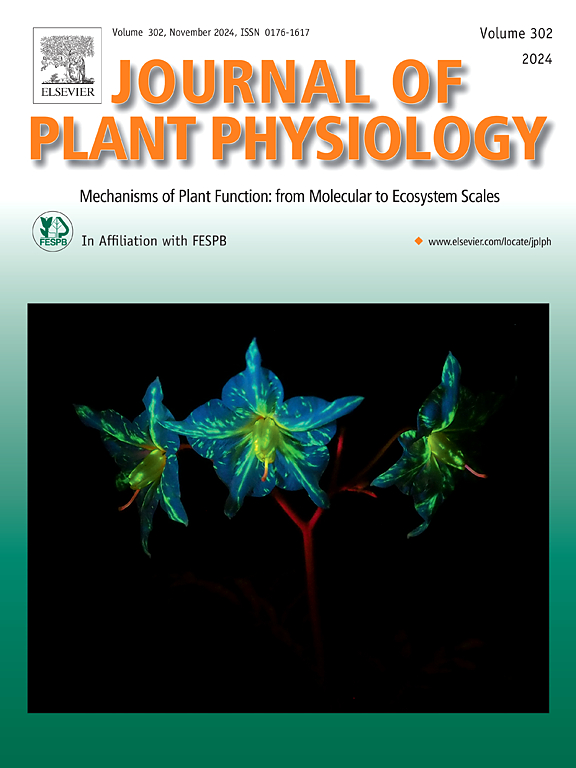基于叶片形态的重金属低积累水稻品种筛选
IF 4.1
3区 生物学
Q1 PLANT SCIENCES
引用次数: 0
摘要
本研究旨在探讨水稻叶片形态特征(气孔、叶面积和毛状体密度)对重金属在水稻籽粒中积累的影响。筛选重金属积累量低、适应性强(叶面吸收少)的品种。通过37个水稻品种的田间试验和ABA调控的盆栽试验,探讨了不同叶片表面形态和气孔对糙米镉(Cd)积累的影响。对不同品种叶片形态的分析表明,Cd含量高的5个品种的气孔孔面积比平均值增加了8.92% ~ 38.49%。同时,5个Cd含量高的水稻品种的木质部Cd转运率均高于平均水平,为9.22% ~ 182.58%。整个水稻植株的转运因子表明,水稻从茎叶到轴、从稻壳到糙米的过程对镉的积累至关重要。相关分析和结构方程模拟结果表明,水稻叶片气孔与Cd在木质部的转运速率之间存在显著的相关关系。ABA喷施试验表明,气孔调节水稻蒸腾作用,影响水稻体内镉的转运和积累。结果表明,施用ABA可显著降低糙米Cd含量2.4% ~ 24%,蒸腾速率33.17% ~ 54.45%;最终,以气孔面积较小、糙米中重金属含量较低的品种朱良优35为宜选品种。本文章由计算机程序翻译,如有差异,请以英文原文为准。

Screening of rice varieties with low accumulation of heavy metals based on leaf morphology
This study aimed to investigate the influence of the morphological traits of rice leaves (stomata, leaf area, and trichome density) on the accumulation of heavy metals in rice grains. It also screens for varieties with low heavy metal accumulation and high adaptability (less foliar uptake). Field trials on 37 rice varieties and pot trials regulated by abscisic acid (ABA) were conducted to explore the effects of various leaf surface morphologies and stomata on cadmium (Cd) accumulation in brown rice. Analyzing leaf morphology in different rice varieties revealed that five with high Cd content had an 8.92 %–38.49 % increase in stomatal pore area compared to the average. Meanwhile, these five rice varieties with high Cd content exhibited xylem Cd transit rates above average, ranging from 9.22 % to 182.58 %. Transporter factors throughout the rice plant indicated that the processes from stem-leaf to rachis and husk to brown rice are crucial for Cd accumulation in rice. The results of the correlation and structural equation modelling indicated a significant correlation between rice leaf stomata and the transit rate of Cd in rice xylem. ABA spraying experiments showed that stomata regulate rice transpiration and affect Cd transport and accumulation in rice. Results showed that ABA spraying significantly reduced Cd content in brown rice by 2.4 %–24 % and transpiration rate (33.17 %–54.45 %). Ultimately, the variety ZhuLiangYou 35, characterized by its smaller stomatal pore area and reduced heavy metal concentration in brown rice, is recommended as an appropriate choice.
求助全文
通过发布文献求助,成功后即可免费获取论文全文。
去求助
来源期刊

Journal of plant physiology
生物-植物科学
CiteScore
7.20
自引率
4.70%
发文量
196
审稿时长
32 days
期刊介绍:
The Journal of Plant Physiology is a broad-spectrum journal that welcomes high-quality submissions in all major areas of plant physiology, including plant biochemistry, functional biotechnology, computational and synthetic plant biology, growth and development, photosynthesis and respiration, transport and translocation, plant-microbe interactions, biotic and abiotic stress. Studies are welcome at all levels of integration ranging from molecules and cells to organisms and their environments and are expected to use state-of-the-art methodologies. Pure gene expression studies are not within the focus of our journal. To be considered for publication, papers must significantly contribute to the mechanistic understanding of physiological processes, and not be merely descriptive, or confirmatory of previous results. We encourage the submission of papers that explore the physiology of non-model as well as accepted model species and those that bridge basic and applied research. For instance, studies on agricultural plants that show new physiological mechanisms to improve agricultural efficiency are welcome. Studies performed under uncontrolled situations (e.g. field conditions) not providing mechanistic insight will not be considered for publication.
The Journal of Plant Physiology publishes several types of articles: Original Research Articles, Reviews, Perspectives Articles, and Short Communications. Reviews and Perspectives will be solicited by the Editors; unsolicited reviews are also welcome but only from authors with a strong track record in the field of the review. Original research papers comprise the majority of published contributions.
 求助内容:
求助内容: 应助结果提醒方式:
应助结果提醒方式:


